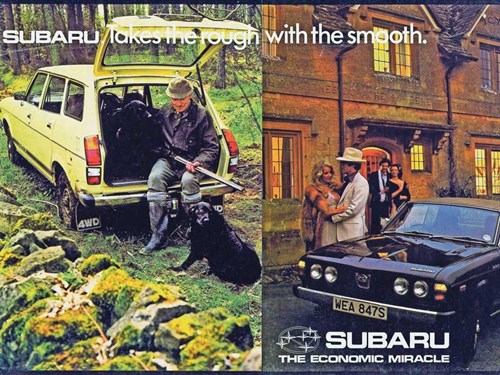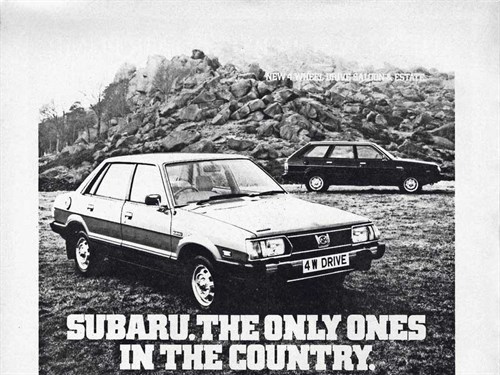It copied the Range Rover’s trick of blending off-road ability and on-road comfort for a fraction of the British 4x4’s price

If you were in the market for a small estate car back in 1977 nothing about Subaru Leone (renamed the 1600GL or 1800GLF in the UK) would have initially appeared unexceptional. The marque name would have been new to most British motorists, but Japanese cars were already a well-established aspect of UK motoring.
Virtually every High Street would have at least one Datsun, Toyota, Honda or Mazda, so the Subaru’s ornate and faintly transatlantic lines would have instantly branded it as ‘one of those Japanese cars’. And if the Subaru’s styling looked dated 39 years ago – the thick pillars and the sharp nose clearly marked it as an early 1970s design – the pleasant equipment levels were certainly an attraction.
Another bonus was the five-door estate version, for aside from the Morris Marina, all comparable British estate cars had a three-door configuration. In the company’s sales brochure were pictures of a 4WD estate that, tantalisingly, offered a switch from front-wheel to four-wheel drive that could be ‘made without declutching, without even slowing down’.
CAR magazine tested one in April 1979 and concluded that the Subaru’s ‘ugliness, and wastefully designed body notwithstanding, showed it was a serious 4WD, with ruggedness and ability far beyond its appearances’. Coming from CAR magazine of that time this was high praise indeed.
The Leone can trace is roots back to 1970, when a Subaru dealer in Japan was approached by a manager from the Tohoku Electric Power Company (TEPCO). Powerline maintenance teams often had to contend with deep snow, but the chap from TEPCO wanted an alternative to the company’s Toyota Land Cruisers which their drivers found cold and uncomfortable in regular use.
What the company really wanted was a light four-wheel drive estate car that was rugged but comfortable to use during the summer months. The response by Subaru’s manufacturer, Fuji Heavy Industries, was to dismantle the flat floor of an FF1 estate and connect a propshaft to the rear axle. Two prototypes were tested in 1971 and eight models went into production, five being used by TEPCO and three entering government service.
Compared with the standard wagons, the four-wheel drive versions had four inches more ground clearance than the standard model to accommodate the running gear, and the rear axle and differential were sourced from the Datsun 510 Bluebird.
The fact that the FF1’s engine and transmission layout proved adaptable to the conversion did not go unnoticed by Fuji Heavy Industries’ management when it was planning a replacement. The Leone of 1971 was a larger car with slightly awkward Nissan-influenced lines (the older firm had taken a 20% share in Subaru in 1968), but following the FF1’s formula. The first model was a coupé, joined by a saloon the following year, but the major news in October 1972 was the 4WD Leone estate, launched at the Winter Olympics in Sapporo and the car to really establish the Subaru name in world markets.
One key export territory was the USA, where Subarus had officially been sold since 1970. Prior to that there had been an attempt – without factory approval – to market the 360 in the United States, but that attracted a memorable Consumer Reports review headlined The Most Unsafe Car In America.
The FF1 proved popular enough to vanquish memories of the 360’s suicide doors flying open on freeways. When the Leone arrived in the USA in 1972 it was renamed the GL (a reference to its trim level) and often re-sold in terms of economy, an increasingly important PR word in the wake of the 1973 oil crisis. There was also the faintly desperate claim that ‘Once it was beautiful engineering – now it’s beautiful cars too’. And just in case male car buyers in the USA were under the impression that the Leone lacked machismo, a memorable ad stated that ‘Playboy thinks a lot of its Bunny of the Year – that’s why they gave her a Subaru’. Let us discreetly ignore the lamentable ad campaign for the GL coupé – ‘Like a spirited woman who yearns to be tamed’ – even if the urging to ‘unleash the relentless power of 1400cc quodrozontal engine’ is funnier than nearly any BBC sitcom of recent memory.
When the four-wheel drive Subarus were first offered to American drivers in 1974, they represented a nimble and practical alternative to a Chevrolet Blazer or Jeep Cherokee. It was easy to drive – ‘front-wheel drive becomes four-wheel drive at the flick of a lever’ – and a respectable accountant or lawyer could enjoy part-time off-road motoring without owning the sort of vehicle associated with people called ‘Zeke’ who lived in Swamp County, Missouri. ‘Climbs like a goat, works like a horse, eats like a bird’ promised the importer.

Ronald Reagan had one!
By 1978, the export-only Brat pick-up – built in response to a request from the president of Subaru America – was so accepted by US drivers that even future US President Ronald Reagan was an owner.
The range had been facelifted in 1977, the year that International Motors of West Bromwich began importing Subarus into the UK. Although they offered quite a complete range of cars, including the rather appealing GLF coupé, it was the 4WD models that were the focus of the line-up. The sort of motorist who would have been attracted to the Matra Rancho would probably have not looked twice at the low-key Subaru, but the nudge-barred wonder was deliberately aimed at suburban poseurs.
The British market Subaru Leones (renamed, as in America, as the GL and GLF) were marketed to appeal to farmers, agricultural equipment dealers, and anyone who needed to drive off-road for at least part of their professional life, but who also wanted a reasonably priced estate of sober appearance.
By the end of the 1970s, it was not unusual to see GLFs packed with farming machinery travelling across rural England, and during the Big Winter of 1978/1979 one of my most vivid memories is of a Subaru estate ploughing past stricken Ford Cortina GLs and Chrysler Avengers.
A quarter of the 4553 examples sold in the UK during 1979 were the 4WD estate and the range was expanded in 1980 with an all-wheel drive saloon. This, promised Subaru, was ‘the complete answer for the professional – businessman, farmer, doctor or vet – who must keep going but who still want the comfort and performance of a car’.
The 1600GL 4WD saloon was slow, with a top speed of around 87mph, but for just under £5000
– or only £400 more than the Morris Marina 1.7 HL – a driver could have a pleasant-looking family car that really could double as an off-road vehicle.
Motor magazine grumbled about the ‘mediocre ride, handling, economy and accommodation’, but did conclude that its unique ability to combine two forms of motoring ‘might make it a very attractive proposition to a lot of people’.
The first-generation GL was replaced in 1984. Today, the first Subarus in the UK are nearly forgotten due to a combination of rust and the curious belief held in some quarters that the history of the marque started with the Impreza.
But it was the modest looking 4WD estate that remains one of the company’s most important cars, a ground-breaking vehicle capable of taking ‘enormous loads across miles of rough ground by day, then take you out to dinner by night’. And in 1977, no other new car in the UK could offer such a combination at such a reasonable price.
